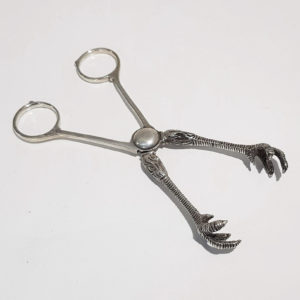Cutlery
Before the 18th century the only items of table silver made in any quantity were spoons. Plates and knives were set on the table, food was cut with the knife and eaten with one’s personal spoon (or fingers). Silver forks were introduced from France in the mid 17th century but are rare prior to the 18th century. It is unusual to find sets of table silver dating earlier than the late 18th century.
The hallmarks on pre 1780 table silver are often squashed and distorted. At that time the silver marks used to be struck on the thin part of the stem which distorted the form of the piece and required the silversmith to hammer the piece back into shape. From c.1780 onwards the Assay Office stamped table silver near the top of the stem as opposed to on the stem just below the bowl, and hallmarks are generally much clearer because there is more space on which to strike them.
Canteens of Antique Silver Cutlery
Table silver was made in sets from circa 1690 onwards but did not come into popular use until the late 18th century when fashionable hosts started to lay their tables with a matching set of cutlery and flatware for their guests. Boxed sets were displayed on the sideboard and could be carried to other family residences. They became popular wedding presents when mass production made them affordable in the 1900s. Nowadays these complete sets of cutlery are generally sold without a fitted box or table. The word canteen remains in use describing an area for communal dining.
Mother of Pearl Cutlery
In the late 19th century sets of cutlery and serving pieces with real mother of pearl handles became popular. They are often found in their original fitted boxes and make attractive wedding gifts. Cutlery handles made from real mother of pearl shell occasionally have a slight variation in grain and size.
Knives – Silver Handled Knives, Skewers and Carving Sets. The word “cutlery” is used generically today to describe all knives, forks and spoons however it was originally used solely for knives and other related cutting instruments. The origin of the word “cutlery” comes from the old French word “coutelier. By the 18th century the provincial English town of Sheffield had become an international centre of the cutlery industry making knives with hollow silver handles that were stamped in two halves, soldered together and inserted with a steel knife blade. Nowadays the original steel blades are often replaced with stainless steel blades which are easier to maintain.
Spoons and Forks –
Collectors Spoons, Dinner, Soup and Dessert Spoons, Serving Spoons.
Tea, Coffee, Salt and Mustard Spoons
Caddy Spoons, Marrow Spoons, Mote Spoons
Before the 18th century the only items of table silver made in any quantity were spoons. Early English silver spoons can date from as early as the 15th century and are highly collectible, especially spoons by rare makers and from unusual provincial towns. The most popular form of cast terminal was the seal top spoon, named after the circular disc at the top, which often bore the engraved initials of the owners. Lion sejant spoons and apostle spoons were also common from the 15th century to the beginning of the 17th century. From the late 16th century the plain flattened stem of the slip top spoon was introduced which developed during the 17th century into the popular trefid form.
Forks. Silver Dinner and Dessert Forks are rare before the 18th century and are not often found in sets until the late 1700s.
The Sucket Fork is an implement with a teaspoon bowl at one end and a two pronged fork at the other. Very rare and only produced from the late 17th century until the early 18th century.
Serving Pieces –
Serving Spoons, Basting Spoons, Ladles,
Serving Slices, Asparagus Tongs, Grape Shears, Sugar Nips
As formal table silverware developed during the 18th century many different forms of serving pieces were introduced with very specific functions.
Long handled serving spoons have been in use since c.1680 and the early spoons had tubular handles. These are usually termed as basting or stuffing spoons; the earliest super large size is termed as a hash spoon
Punch ladles were introduced in the early 1700’s and differ from other ladles in the fact that they have turned wood or twisted whalebone handles. Originally they had round bowls which were superseded in about 1735 by egg shaped bowls. Later on lips were added and after 1760 they were often inset with silver coins.Silver soup and sauce ladles date from George II period and later.
The first fish slice, made in circa 1740, originally had a triangular blade and these are now highly sought after to serve cake and pastries.
Asparagus servers with a serrated blade and chop tongs date from the end of the 18th century.
Grape shears are not found until the 19th century. These are often in presentation boxes and can have beautiful grapevine decoration.
Caddy spoons for measuring out tea leaves were made from 1780 onwards.
Cutlery
Before the 18th century the only items of table silver made in any quantity were spoons. Plates and knives were set on the table, food was cut with the knife and eaten with one’s personal spoon (or fingers). Silver forks were introduced from France in the mid 17th century but are rare prior to the 18th century. It is unusual to find sets of table silver dating earlier than the late 18th century.
The hallmarks on pre 1780 table silver are often squashed and distorted. At that time the silver marks used to be struck on the thin part of the stem which distorted the form of the piece and required the silversmith to hammer the piece back into shape. From c.1780 onwards the Assay Office stamped table silver near the top of the stem as opposed to on the stem just below the bowl, and hallmarks are generally much clearer because there is more space on which to strike them.
Canteens of Antique Silver Cutlery
Table silver was made in sets from circa 1690 onwards but did not come into popular use until the late 18th century when fashionable hosts started to lay their tables with a matching set of cutlery and flatware for their guests. Boxed sets were displayed on the sideboard and could be carried to other family residences. They became popular wedding presents when mass production made them affordable in the 1900s. Nowadays these complete sets of cutlery are generally sold without a fitted box or table. The word canteen remains in use describing an area for communal dining.
Mother of Pearl Cutlery
In the late 19th century sets of cutlery and serving pieces with real mother of pearl handles became popular. They are often found in their original fitted boxes and make attractive wedding gifts. Cutlery handles made from real mother of pearl shell occasionally have a slight variation in grain and size.
Knives – Silver Handled Knives, Skewers and Carving Sets. The word “cutlery” is used generically today to describe all knives, forks and spoons however it was originally used solely for knives and other related cutting instruments. The origin of the word “cutlery” comes from the old French word “coutelier. By the 18th century the provincial English town of Sheffield had become an international centre of the cutlery industry making knives with hollow silver handles that were stamped in two halves, soldered together and inserted with a steel knife blade. Nowadays the original steel blades are often replaced with stainless steel blades which are easier to maintain.
Spoons and Forks –
Collectors Spoons, Dinner, Soup and Dessert Spoons, Serving Spoons.
Tea, Coffee, Salt and Mustard Spoons
Caddy Spoons, Marrow Spoons, Mote Spoons
Before the 18th century the only items of table silver made in any quantity were spoons. Early English silver spoons can date from as early as the 15th century and are highly collectible, especially spoons by rare makers and from unusual provincial towns. The most popular form of cast terminal was the seal top spoon, named after the circular disc at the top, which often bore the engraved initials of the owners. Lion sejant spoons and apostle spoons were also common from the 15th century to the beginning of the 17th century. From the late 16th century the plain flattened stem of the slip top spoon was introduced which developed during the 17th century into the popular trefid form.
Forks. Silver Dinner and Dessert Forks are rare before the 18th century and are not often found in sets until the late 1700s.
The Sucket Fork is an implement with a teaspoon bowl at one end and a two pronged fork at the other. Very rare and only produced from the late 17th century until the early 18th century.
Serving Pieces –
Serving Spoons, Basting Spoons, Ladles,
Serving Slices, Asparagus Tongs, Grape Shears, Sugar Nips
As formal table silverware developed during the 18th century many different forms of serving pieces were introduced with very specific functions.
Long handled serving spoons have been in use since c.1680 and the early spoons had tubular handles. These are usually termed as basting or stuffing spoons; the earliest super large size is termed as a hash spoon
Punch ladles were introduced in the early 1700’s and differ from other ladles in the fact that they have turned wood or twisted whalebone handles. Originally they had round bowls which were superseded in about 1735 by egg shaped bowls. Later on lips were added and after 1760 they were often inset with silver coins.Silver soup and sauce ladles date from George II period and later.
The first fish slice, made in circa 1740, originally had a triangular blade and these are now highly sought after to serve cake and pastries.
Asparagus servers with a serrated blade and chop tongs date from the end of the 18th century.
Grape shears are not found until the 19th century. These are often in presentation boxes and can have beautiful grapevine decoration.
Caddy spoons for measuring out tea leaves were made from 1780 onwards.
-

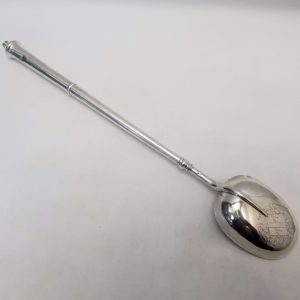
1697
William Fawdery
10235 William III Antique Silver Cannon Handle Spoon
Sold
A massive antique sterling silver hash spoon with the long tubular handle and a large deep bowl with a rattail extension to the underside. This elegant form is known as a Cannon handled spoon and can be used as a basting or stuffing spoon. Very useful size. To the reverse of the handle terminal there is an intricate hand engraved armorial. Weight 234 grams, 7.5 troy oz. Length 44.5cm. Bowl 10.4 x 7.5cm. London 1697. Maker probably William Fawdery. Britannia standard silver.
-

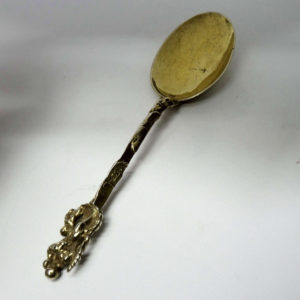
Circa 1728
Abraham Marshoorn
8965 Antique Silver Spoon
£450
An excellent antique Dutch gilt silver spoon. Cast silver. The finial is modelled with a seated figure holding a baby and accompanied by a cherub, an allegorical representation of maternal love. The back of the bowl is inscribed with the owners initials. Weight 61 grams, just under 3 troy ounces. Length 18.3 cms. Bowl measures 7×5 cms. Amsterdam, Netherlands. 1728.
-

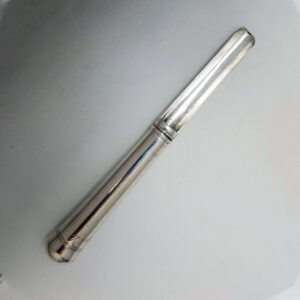
Circa 1780
Nathaniel Gillert
10285 George III Antique Silver Apple Corer
Sold
-

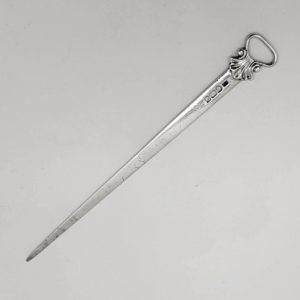
1782
William Sumner
9607 Antique Silver Skewer
£350
An attractive antique silver meat skewer with decorative ring handle. Can also be used as a letter opener. Uninscribed. Weight 61 grams, 1 troy ounce. Length 24.5 cm. London 1782. Maker probably William Sumner.
-

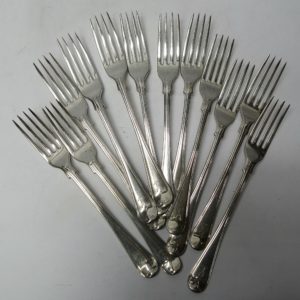
1795
Thomas Wallis I
9088 Antique Silver Forks
Sold
A set of Georgian sterling silver dinner forks for 12 people. In the traditional Old English and thread pattern. All with a hand engraved stag crest. Weight approx 800 grams, 25.7 troy ounces. Length 21cm. London 1795. Maker Thomas Wallis. These match the dinner forks in #9078 Georgian canteen of cutlery.
-

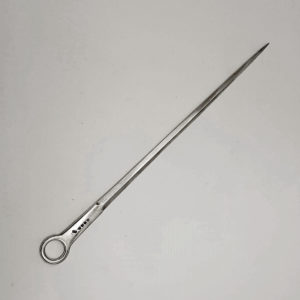
1798
William Ely
9597 Antique Silver Skewer
£350
A good quality antique silver meat skewer with ring handle. Can also be used as a letter opener. Uninscribed. Weight 133 grams, 4.2 troy ounces. Length 35 cm. London 1798. Maker William Ely II.
-

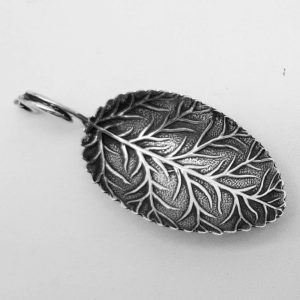
Circa 1800
Joseph Taylor
9856 George III Silver Caddy Spoon
£235
A charming little antique silver spoon with wire scroll handle, the bowl fashioned as a leaf. Weight 8 grams. Length 7cm. Width 3cm. Lion mark only. This type of spoon was generally made in Birmingham. Maker probably Joseph Taylor. Circa 1800.
-

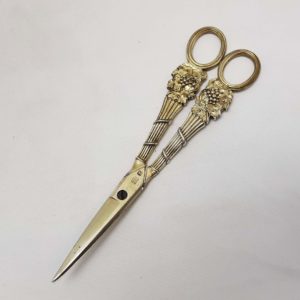
1810
Eley‚ Fearn & Chawner
10265 George III Antique Silver Grape Scissors
Sold
An excellent quality pair of antique silver grape shears with the original bright gilt finish. Good quality cast silver with reeded handles and silver grape and vine leaf decoration. Weight 109 grams, 3.5 troy ounces. Length 18cm. Width 5 cm. London 1810. Maker Eley, Fearn & Chawner. Sterling silver. 19th century.
-

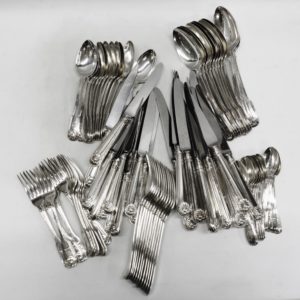
1812 - 1815
Eley‚ Fearn & Chawner
9254 Canteen of Georgian Silver Cutlery for 12
Sold
An extensive set of antique sterling silver cutlery for 12 people. 84 pieces. Very elegant fiddle, thread and shell pattern. Together with a full set of vintage sterling silver knives. The flatware all has a hand engraved crest of an elephant. Weight excluding knives 3288 grams, 105.7 troy ounces. Flatware all by Eley Fearn & Chawner London 1812 (except the 12 dessert forks London 1815, no makers mark). Knives by Vanders, Sheffield 1982.
-

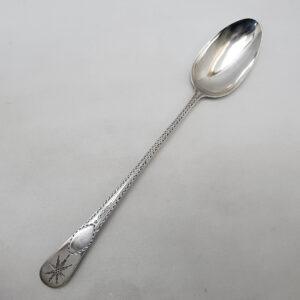
1823
William Sumner
10299 George III Antique Silver Serving Spoon
£285
An attractive antique silver basting spoon in the popular Old English pattern. The long slender handle is prettily engraved with bright cutting and a star pattern. Weight 96 grams, 3 troy ounces. Length 29.8cm. Bowl 9×4.9cm. London 1823. Maker William Sumner. Sterling silver. 19th century.
-

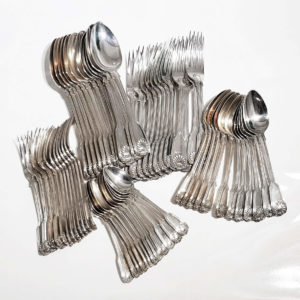
1834 - 1838
Mary Chawner
9742 Antique Canteen of Cutlery
Sold
A handsome set of antique sterling silver cutlery for 12 people. 60 pieces. Very elegant fiddle, thread and shell pattern. Total weight excluding knives 4314 grams, 138.7 troy ounces. Flatware all by Mary Chawner London 1834/5 (except 2 dinner forks London 1838). Sterling silver.
-

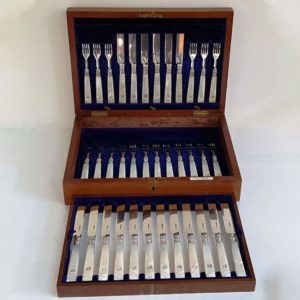
1850
Aaron Hadfield
9908 Antique Silver and Mother of Pearl Cutlery
Sold
A large set of 18 knives and 18 forks with elegant plain styled silver blades. Dessert cutlery. The real mother of pearl handles have ornate silver ferules with cross hatch decoration. Engraved to each handle is a boars head crest. Original solid wood box with blue velvet interior and a pull out tray. Knife 20.8cm. Fork 17cm. Sheffield 1850. Maker Aaron Hadfield. Sterling silver.
-

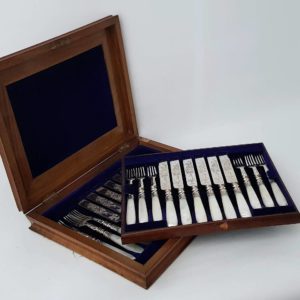
1870
Martin Hall and Co
9831 Antique Silver and Mother of Pearl Cutlery
Sold
A set of 12 knives and 12 forks with pretty blades finely engraved with flower and foliate decoration. The real mother of pearl handles have ornate ferules with bead borders. Original cushion shaped wooden box with blue velvet interior. Knife 22.2cm. Fork 18.3cm. Sheffield 1870. Maker Martin Hall. Sterling silver.
-

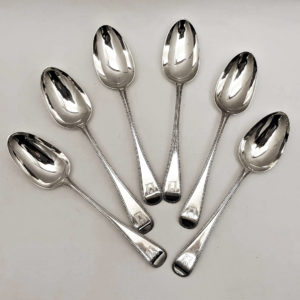
1878
Henry Holland
7971 Antique Silver Serving Spoons
Sold
A superb set of 6 antique sterling silver spoons in the elegant bead pattern. Excellent plain style. Each piece has a hand engraved crest. Total weight, 6 spoons, 435 grams, 13.9 troy oz. Length 22.5cm. London 1878. Maker Henry Holland.
-

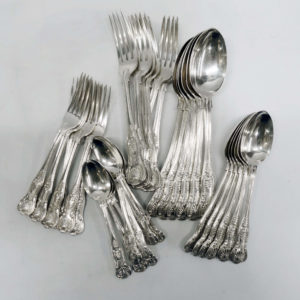
1896 - 1897
Francis Higgins
9262 Antique Silver Canteen of Kings Cutlery
Sold
An excellent set of sterling silver cutlery for 6 people in the popular Kings pattern. Total 31 pieces. Weight 2261 grams, 72.7 troy ounces. All pieces London 1896-7, maker Francis Higgins.
-

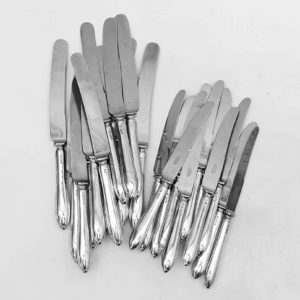
1927
Charles Boynton
10105 Vintage Silver Knives for 12
£750
A good set of 12 silver handled dinner and dessert knives with stainless steel blades. Smart plain styled handles. Each has a decorative monogram in distinctive lettering. The dinner knives have spatula shaped blades and the dessert knives have pointed blades. The silver handles are unfilled. Length 25/21.5cm. Sheffield 1927. Maker Charles Boyton & Son Ltd.
-

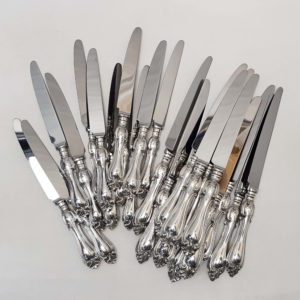
1995
10227 Vintage Silver Knives for 12
£1,150
A handsome set of 12 silver handled dinner and dessert knives with stainless steel blades. Classic decorative pattern. The silver handles are unfilled. Length 25/21.5cm. Sheffield 1995. Maker Terry Shaverin. Sterling silver.
-

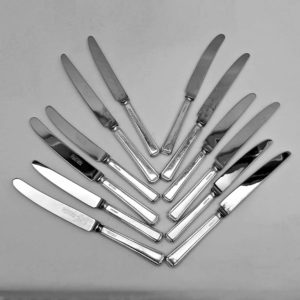
2001 - 2005
9804 Art Deco Silver Knives
£495
A vintage set of 12 silver knives with stainless steel blades. Art deco design with solid silver geometric style, plain handles. Stainless steel blades. 6 dinner knives and 6 dessert knives. Sheffield 2001/2/5. Various makers. Sterling silver.
-

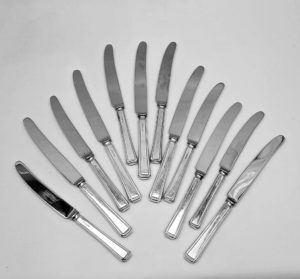
2002
United Cutlery
9798 Art Deco Silver Knives
£495
A vintage set of 12 silver knives with stainless steel blades. Art deco design with sterling silver geometric style, plain handles. The stainless steel blades have the United Cutlery logo. 6 dinner knives, length 24cm, and 6 dessert knives, length 21.5cm. Sheffield 2002. Maker United Cutlery. Sterling silver.
Other matching sets available #9801 and #9804
-

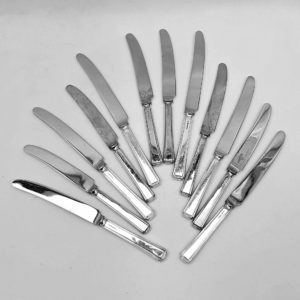
2010
9801 Art Deco Silver Knives
£495
A vintage set of 12 silver knives with stainless steel blades. Art deco design with geometric style, plain handles. The stainless steel blades have no logo stamp. 6 dinner knives, length 24.2cm, and 6 dessert knives, length 22cm. Sheffield 2010. Maker “WT”. Sterling silver.
